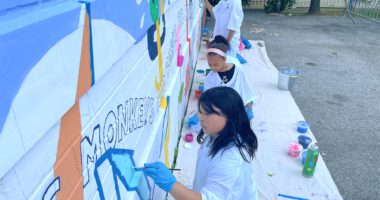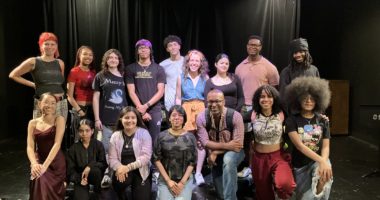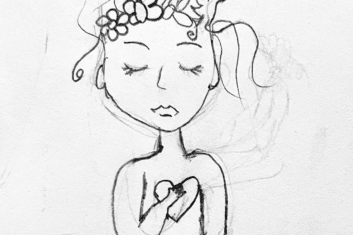In this ongoing series, Katie Rainey, reports from inside the Teaching Artist Training and Internship Program. A graduate of the program, Katie shares her insight into the workshops, seminars and personal experience with classroom internships.
On Saturday, December 6th, Community-Word Project’s Teaching Artist Training and Internship Program (TATIP) held its last fall workshop. It was a day packed full of new Lesson Plans, Teaching Path, Curriculum Planning, and Classroom Management Strategies.
We began with a lesson plan presentation by a group of trainees: Katrina De Wees, Rachael Schefrin, and Anthony Ha. They presented a collaborative theatre and creative writing lesson plan that focused on living images and the theme of consent. Their opening ritual had us stand in a circle and take turns making eye contact with the person to our right and saying what we felt in that moment, such as, “I’m feeling happy/silly/confused.” It was a great way to make interpersonal relationships in the room and open up as a community.
Rachael then gave us an introduction to the Theatre of the Oppressed. She came up with an exercise that called for the participants to use their bodies to create living images. For example, Rachael would call out, “chair,” “tree,” or “superhero” and the players would strike poses of the words. Rachael went quickly, but allowed time for reflection, asking participants to note what poses the other students had chosen, how they differed or were similar, what you could take from one another’s pose, etc.
The group’s main activity consisted of reflecting on definitions of harassment and consent by watching two videos, Hollaback! Harassment Video and A Hollaback! Response Video: Women of Color. They tied this theme to the Theatre of the Oppressed and had the participants create individual living images based on their own experiences with harassment and/or consent.
“It was a great experience to spend so many sessions planning, and then share with a group of art enthusiasts. It’s very difficult to only share 15 minutes of a 45 minute lesson plan, because there was so much we wanted to do and say! Time management then became a critical awareness point, to navigate the equity of the artist/educators work in planning, and balancing the other desires of co-teachers, and what the group of students may be ready to practice.”
-Katrina De Wees, Dancer
After that engaging lesson, Teaching Paths and Curriculum Development were the main topics of the final workshop. At Community-Word Project syllabi are referred to as “teaching paths”. A plotted timeline that contextualizes lesson plans and culminates in a final event, such as a poetry reading, dance/music/theater performance, an exhibition of photographs, or a published anthology of student poetry. Teaching paths are mapped out by weeks and they can be anywhere from 8 weeks to 25 weeks in length.
Instructors Patti Chilsen and Renee Watson discussed what goes into a teaching path: goals of an arts residency, creative skills and outcomes students need to acquire, inquiry questions, etc. The trainees reviewed a sample teaching path and were given lab time to get together with their teaching partners and start co-planning a teaching path.
“The training made me realize that learning is best achieved when we also teach children how they learn, and not just what to learn. By giving children an opportunity to reflect, we develop their critical thinking skills, which helps them become better learners.”
– Cristal Chael Rodriguez, Visual Artist
The afternoon workshop conversation turned to Classroom Management, a hot topic for any group of Teaching Artists. We discussed preventive tips, such as having a “Do Now”. A graffiti wall or a task on the students’ desks, ready to go when they walk in. Or having extra activities for the more energetic students to do when their interest wanes.
Several “call and response” techniques were also shared: “If you hear the sound of my voice, raise your hand. If you hear the sound of my voice, touch your nose, etc.” or “One, two, three, eyes on me. One, two, eyes on you.” We discussed using praise for students who are on track and working, such as awarding sticky notes with encouraging phrases or thanking them in front of the class for their respect. We shared many new techniques for managing our classrooms, but we also reflected on why we need classroom management tools in the first place.
It is important for a Teaching Artist to reflect on what they are teaching. Is it painting, poetry, dance theater? No. The real answer is children. No matter what wisdom or creativity we think we are there to impart, the real reason for our teaching is the children. The moment a child comes into a Community-Word Project classroom, we not only teach them a specific subject, but vital life skills about how to act as a member of a healthy community. This wisdom and respect can often be the most empowering thing in their education and life.
We ended the final fall workshop in true Community-Word Project fashion: reflection. The previous week had seen devastating events so we took time to reflect on the social injustices happening in Ferguson and elsewhere in the country, and what that means for us as educators and artists.
Renee Watson shared some valuable resources with the group on how to teach about what happened in Ferguson and beyond, beginning with an article she wrote, Teach About Mike Brown. But Don’t Stop There.
“At our recent workshop, we had a discussion about how, with events in Ferguson and the Eric Garner decision, we can give ourselves permission to be honest with our students about how we might be feeling around these issues that day. It also provides an opportunity for an honest conversation about how long change takes. In the end, besides bringing ourselves as artists, we’re bringing ourselves as human beings.”
– Stephanie Jones, Writer
We were grateful to have had the opportunity to pause and grieve as a community and to reflect on why what we do matters. We ended with a round of “Shout Outs”, in which we stood in a circle and shouted out people we were thankful for in the group and why. It was a fitting end to our intense workshops and training. However, TATIP doesn’t end there! Stay tuned for some insightful blogs from inside various CWP residencies, brought to you by the trainees themselves!
“It fills me with joy that Community-Word Project has gathered such an amazing group of people that genuinely want to make a difference with youth in the NYC schools. What a fantastic group of people!”
– Beth Cooperman, Theater Artist



